 Facebook
Facebook
 X
X
 Instagram
Instagram
 TikTok
TikTok
 Youtube
Youtube
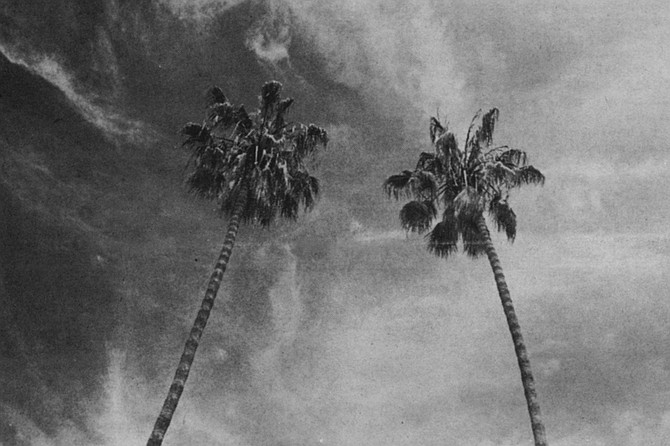
There you are on Sunday afternoon, alone again. You’ve read your paper; you’ve listened to your albums. You wander from room to room in search of a meaningful life. Suddenly your eye falls on a bar of Palmolive soap, and a voice within you says:
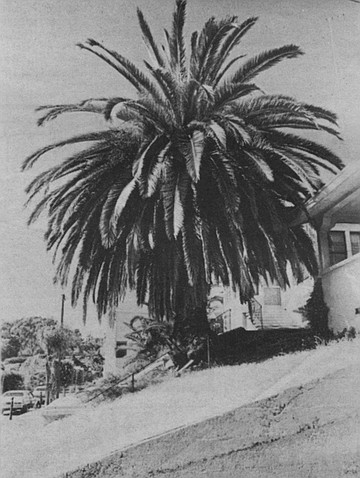
“The African oil palm is the world’s greatest source of vegetable oils used in soaps and other articles.”
Outside your window, the palm tree you hardly noticed before is waving its fronds...gently...beckoning…Who can explain it? You are taken with the urge to know the palm trees on your block. For your convenience, this paper has prepared an illustrated guide:

The Mexican Fan Palm, also called the Skyduster, is a poor excuse for a shade tree, but is welcome in places where people want a skyline without tall buildings.The California Fan Palm, the state’s only native, looks like the Mexican Fan but is shorter and thicker. If left untrimmed, both palms will form a thatch of old leaves from top to bottom.
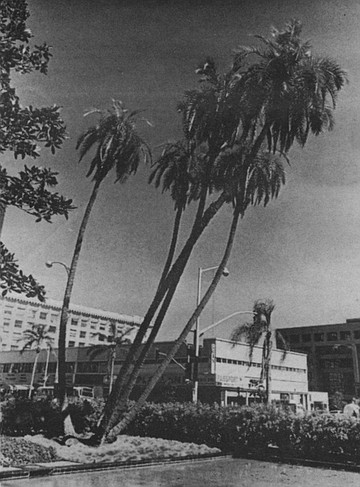
The Canary Island Palm, more often than not, is big, fat, neglected, and dateless. But don’t feel sorry for it. In warmer climates this tree and its many date-cousins are a main source of food and have even been worshipped. Though their fruit does not ripen in this climate, the trees are useful. Pigeons live in them; kids climb them. Their abundant leaves give more shade than other palms. Think of them as protective aunts who live good, rich lives.
The Queen Palm is among the most commonly seen trees in town. A native of Brazil, it is prized for its beauty; but like most beauties it needs constant trimming and attention. The slender trunk has the color and texture of concrete, and in this climate the tree produces nothing useful but its looks.
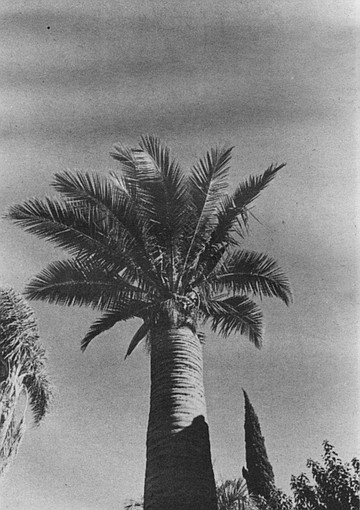
The Senegal Date. Because they exist in clusters and are good for nothing but decoration, these palms may remind you of attorneys. The older they get, the more they bend, a characteristic evolved from living in the wind. Young plants that grow from the base of the cluster are called suckers. These palms are often planted in front of banks and public buildings.
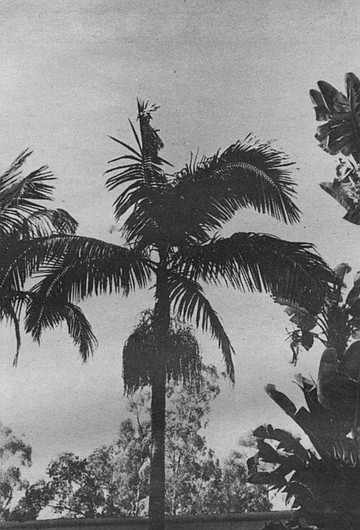
The Windmill Palm, on the other hand, is exceedingly ugly and practical. It has a black, hairy trunk and leaves like fans. (Palm leaves come in only two shapes: fan and feather.) The Chinese use the hairy trunk fibers to make rope, hats, even raincoats. Maybe it is this palm’s ugliness that makes it so tough.
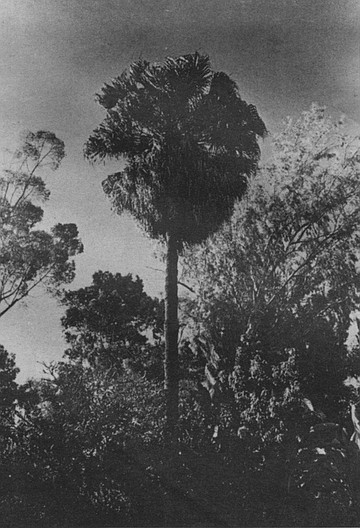
The Wine Palm, distinguished by its monumental trunk, is imported from Chile, where Indians have developed a taste for its sap. All sorts of liquor can be made from palms. The East Indians distill a drink called toddy; from the coconut comes a drink called arrack. Palms supply not only liquor, but lumber, cloth, and fiber for Panama hats; needles, fishhooks, furniture polish; sugar, starch, and waxes used in the care of phonograph records.
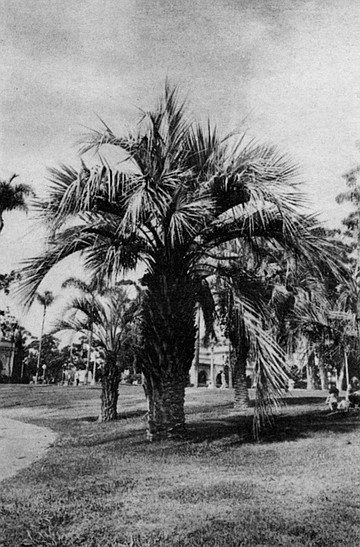
The Fountain Palm’s name is appropriate if you think of the palm as a slow, floral fountain. Like most palms, it is constantly producing a fountain of leaves, flowers, and fruits from its tip-the green, terminal bud. Some people like to eat the bud of the Fountain Palm in a salad, or cook it like a cabbage. This practice, unfortunately, kills the rest of the tree.
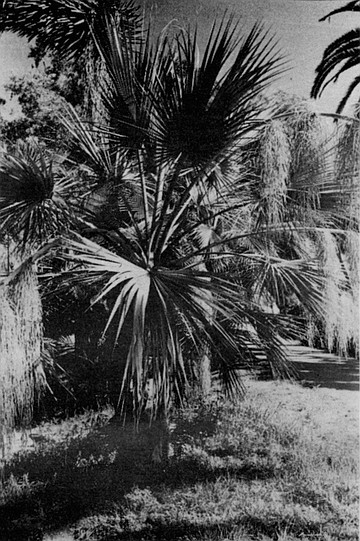
The King Palm, a blatantly sexual plant, flourishes in gardens but not in the street. At the top of the smooth trunk is a slick green sheath, four to six feet long. Purple flowers burst from the bottom of the sheath and turn into bundles of little orange fruits. Inedible.
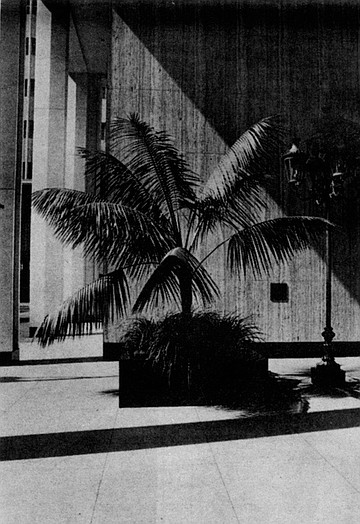
The Pindo Palm’s fruit tastes something like pineapple, and can be made into jelly. You should be cautious with this palm, though, as its leaves have stout spines down where the fruit is. In compensation, the palm is nice to look at—its leaves are milky-green. The trunk, short and fat, is excellent for climbing.
The Mexican Blue Palm. Most persons who have been to Baja California and who have left their motel room in the daytime will recognize this palm. Better than advertised, its fronds are a nice, silvery blue.
The Thatch Palm is the kind of palm grown in expensive buildings and on Lord Howe Island, east of Australia. Its leaves are deep green and lush; they make some people think of money. The palm’s Latin name-Kentia For-senator-is in honor of a senator from New South Wales.


There you are on Sunday afternoon, alone again. You’ve read your paper; you’ve listened to your albums. You wander from room to room in search of a meaningful life. Suddenly your eye falls on a bar of Palmolive soap, and a voice within you says:

“The African oil palm is the world’s greatest source of vegetable oils used in soaps and other articles.”
Outside your window, the palm tree you hardly noticed before is waving its fronds...gently...beckoning…Who can explain it? You are taken with the urge to know the palm trees on your block. For your convenience, this paper has prepared an illustrated guide:

The Mexican Fan Palm, also called the Skyduster, is a poor excuse for a shade tree, but is welcome in places where people want a skyline without tall buildings.The California Fan Palm, the state’s only native, looks like the Mexican Fan but is shorter and thicker. If left untrimmed, both palms will form a thatch of old leaves from top to bottom.

The Canary Island Palm, more often than not, is big, fat, neglected, and dateless. But don’t feel sorry for it. In warmer climates this tree and its many date-cousins are a main source of food and have even been worshipped. Though their fruit does not ripen in this climate, the trees are useful. Pigeons live in them; kids climb them. Their abundant leaves give more shade than other palms. Think of them as protective aunts who live good, rich lives.
The Queen Palm is among the most commonly seen trees in town. A native of Brazil, it is prized for its beauty; but like most beauties it needs constant trimming and attention. The slender trunk has the color and texture of concrete, and in this climate the tree produces nothing useful but its looks.

The Senegal Date. Because they exist in clusters and are good for nothing but decoration, these palms may remind you of attorneys. The older they get, the more they bend, a characteristic evolved from living in the wind. Young plants that grow from the base of the cluster are called suckers. These palms are often planted in front of banks and public buildings.

The Windmill Palm, on the other hand, is exceedingly ugly and practical. It has a black, hairy trunk and leaves like fans. (Palm leaves come in only two shapes: fan and feather.) The Chinese use the hairy trunk fibers to make rope, hats, even raincoats. Maybe it is this palm’s ugliness that makes it so tough.

The Wine Palm, distinguished by its monumental trunk, is imported from Chile, where Indians have developed a taste for its sap. All sorts of liquor can be made from palms. The East Indians distill a drink called toddy; from the coconut comes a drink called arrack. Palms supply not only liquor, but lumber, cloth, and fiber for Panama hats; needles, fishhooks, furniture polish; sugar, starch, and waxes used in the care of phonograph records.

The Fountain Palm’s name is appropriate if you think of the palm as a slow, floral fountain. Like most palms, it is constantly producing a fountain of leaves, flowers, and fruits from its tip-the green, terminal bud. Some people like to eat the bud of the Fountain Palm in a salad, or cook it like a cabbage. This practice, unfortunately, kills the rest of the tree.

The King Palm, a blatantly sexual plant, flourishes in gardens but not in the street. At the top of the smooth trunk is a slick green sheath, four to six feet long. Purple flowers burst from the bottom of the sheath and turn into bundles of little orange fruits. Inedible.

The Pindo Palm’s fruit tastes something like pineapple, and can be made into jelly. You should be cautious with this palm, though, as its leaves have stout spines down where the fruit is. In compensation, the palm is nice to look at—its leaves are milky-green. The trunk, short and fat, is excellent for climbing.
The Mexican Blue Palm. Most persons who have been to Baja California and who have left their motel room in the daytime will recognize this palm. Better than advertised, its fronds are a nice, silvery blue.
The Thatch Palm is the kind of palm grown in expensive buildings and on Lord Howe Island, east of Australia. Its leaves are deep green and lush; they make some people think of money. The palm’s Latin name-Kentia For-senator-is in honor of a senator from New South Wales.
Comments